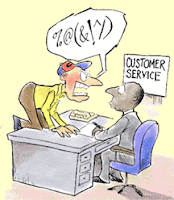How do you deal with a difficult customer? Well what is a ‘difficult customer?’ Being difficult means that their behaviour causes the problem, so learning to deal with these people means learning to deal with difficult behaviour.
The key to the problem is realising that you cannot deal with their difficult behaviour – all you can do is to learn to manage your own reaction and response.
All communication is, by its nature, a two way transaction. So if we respond to their part in the transaction with anger or defensiveness we simply make the problem worse. By taking the customer’s anger personally we react in a negative way which impacts on our ability to recast the communication in a positive way.
This is not our usual reaction – that is more likely to be:
1. Defensive – this is natural, when we are attacked we instinctively trigger our defence mechanism. But if our reaction to a customer’s angry complaint is only defensive we solve nothing. And worse we can wind up as frustrated as they are, and right in the middle of a shouting match. So being defensive is not the answer.
2. Reciprocal Anger – You may find yourself getting angry in return, which a road is leading to disaster. Even if you are trying to focus on the situation, your anger is going to impede a solution.
We need to recognise that the customer is not mad at us personally, they are angry and frustrated at the situation they find themselves in. What we need to focus on is first understanding what the problem is as the client sees it, and concentrate on trying to solve that problem.By concentrating on the problem, by refusing to take the abuse personally you can take a negative situation and turn it positively around.
So when the customer is loudly complaining try some of these suggestions:
1. Take notes of the details of the problem. If this is not immediately clear (And angry people sometimes have difficulty in articulating the underlying problem) try courteous questions or confirming feedback “Now let me see if I have this correct, what happened was…”. Courtesy will soothe the anger and the feedback indicates to the customer that you are taking the complaint seriously and actually listening.
2. Ask the customer what would be their preferred outcome. Do they want a refund or replacement etc. If this is not company policy, you will have to explain why this is, and try to have an alternative option. “I am sorry our company policy does not allow for a cash refund but I can replace your defective toaster with another of similar brand and price.” Most people need to have their complaint recognised and will often accept the alternative suggestion if this is done.
Trying to pass the buck is not the answer, because the customer doesn’t usually care whose fault it is, they merely want the problem fixed. So stay calm and take a positive approach by focussing on the problem not the behaviour. If you do, you will usually find that when the problem has been solved the customer will say “I am sorry that I yelled at you, but I was so frustrated.” A difficult tiger has been turned into a pussy cat, merely by refocussing the response.
Michele @ Trischel

